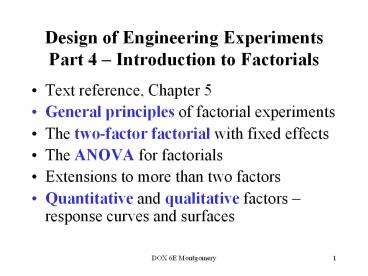Design%20of%20Engineering%20Experiments%20Part%204%20 - PowerPoint PPT Presentation
Title:
Design%20of%20Engineering%20Experiments%20Part%204%20
Description:
Design of Engineering Experiments Part 4 Introduction to Factorials Text reference, Chapter 5 General principles of factorial experiments The two-factor factorial ... – PowerPoint PPT presentation
Number of Views:137
Avg rating:3.0/5.0
Title: Design%20of%20Engineering%20Experiments%20Part%204%20
1
Design of Engineering ExperimentsPart 4
Introduction to Factorials
- Text reference, Chapter 5
- General principles of factorial experiments
- The two-factor factorial with fixed effects
- The ANOVA for factorials
- Extensions to more than two factors
- Quantitative and qualitative factors response
curves and surfaces
2
Some Basic Definitions
Definition of a factor effect The change in the
mean response when the factor is changed from low
to high
3
The Case of Interaction
4
Regression Model The Associated Response Surface
5
The Effect of Interaction on the Response Surface
Suppose that we add an interaction term to the
model
Interaction is actually a form of curvature
6
Example 5-1 The Battery Life ExperimentText
reference pg. 165
- A Material type B Temperature (A
quantitative variable) - What effects do material type temperature have
on life? - 2. Is there a choice of material that would
give long life regardless of temperature (a
robust product)?
7
The General Two-Factor Factorial Experiment
a levels of factor A b levels of factor B n
replicates This is a completely randomized design
8
Statistical (effects) model
Other models (means model, regression models) can
be useful
9
Extension of the ANOVA to Factorials (Fixed
Effects Case) pg. 177
10
ANOVA Table Fixed Effects Case
Design-Expert will perform the computations Text
gives details of manual computing (ugh!) see
pp. 169 170
11
Design-Expert Output Example 5-1
12
Residual Analysis Example 5-1
13
Residual Analysis Example 5-1
14
Interaction Plot
15
Quantitative and Qualitative Factors
- The basic ANOVA procedure treats every factor as
if it were qualitative - Sometimes an experiment will involve both
quantitative and qualitative factors, such as in
Example 5-1 - This can be accounted for in the analysis to
produce regression models for the quantitative
factors at each level (or combination of levels)
of the qualitative factors - These response curves and/or response surfaces
are often a considerable aid in practical
interpretation of the results
16
Quantitative and Qualitative Factors
17
Quantitative and Qualitative Factors
Candidate model terms from Design- Expert
Intercept A B B2 AB B3 AB2
A Material type B Linear effect of
Temperature B2 Quadratic effect of
Temperature AB Material type TempLinear AB2
Material type - TempQuad B3 Cubic effect of
Temperature (Aliased)
18
Regression Model Summary of Results
19
Regression Model Summary of Results
20
Factorials with More Than Two Factors
- Basic procedure is similar to the two-factor
case all abckn treatment combinations are run
in random order - ANOVA identity is also similar
- Complete three-factor example in text, Example 5-5































